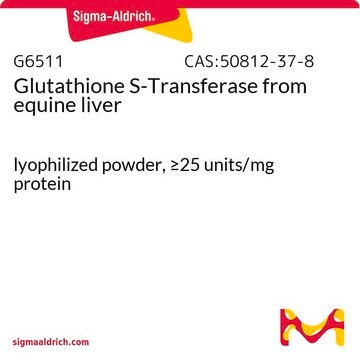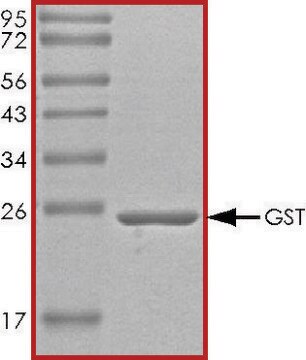GS52
GST T2-2, Recombinant Human
Synonym(s):
glutathione S-transferase theta 2
Sign Into View Organizational & Contract Pricing
All Photos(1)
About This Item
UNSPSC Code:
12352200
NACRES:
NA.26
Recommended Products
biological source
human
Quality Level
recombinant
expressed in E. coli
Assay
>95% (SDS-PAGE)
form
frozen liquid
specific activity
12.6 units/mg protein
mol wt
25 kDa
concentration
1.91 mg/mL
storage temp.
−70°C
Gene Information
human ... GSTT2(2953)
General description
Glutathione S-transferase theta 2 (GSTT2) is an enzyme that in humans is encoded by the GSTT2 gene. GSTT2 is mapped to human chromosome 22q11.2.
as assayed by the spectrophotometric determination of NADPH oxidation coupled to the glutathione peroxidase activity of GST T2-2 on cumene hydroperoxide (1.5 mM) in the presence of reduced glutathione (1 mM) in 100 mM NaPO4 (pH 7.0) at room temperature.
Biochem/physiol Actions
Glutathione S-transferases (GSTs) are a family of enzymes that play an important role in detoxification by catalyzing the conjugation of many hydrophobic and electrophilic compounds with reduced glutathione. Based on their biochemical, immunologic, and structural properties, cytosolic and membrane-bound forms of glutathione S-transferase are encoded by two distinct supergene families. At present, eight distinct classes of the soluble cytoplasmic mammalian glutathione S-transferases have been identified: α, κ, μ, ω, π, σ, θ and ζ. The GSTs are thought to function in xenobiotic metabolism and play a role in susceptibility to cancer, and other diseases.
The θ class includes GSTT1, GSTT2, and GSTT2B. GSTT2 and GSTT2B are nearly identical to each other, and share 55% amino acid identity with GSTT1. All three genes may play a role in human carcinogenesis. The GSTT2 gene is a pseudogene in some populations.
Storage and Stability
The enzyme should be used by the end-user customer within 1 year of receipt.
Storage Class Code
10 - Combustible liquids
WGK
WGK 1
Flash Point(F)
Not applicable
Flash Point(C)
Not applicable
Certificates of Analysis (COA)
Search for Certificates of Analysis (COA) by entering the products Lot/Batch Number. Lot and Batch Numbers can be found on a product’s label following the words ‘Lot’ or ‘Batch’.
Already Own This Product?
Find documentation for the products that you have recently purchased in the Document Library.
Glutathione S-transferases: an overview in cancer research.
Di Pietro G, et al.
Expert Opinion on Drug Metabolism & Toxicology, 6(2), 153-170 (2010)
Glutathione transferases: substrates, inihibitors and pro-drugs in cancer and neurodegenerative diseases.
Allocati N, et al.
Oncogenesis, 7(1), 8-8 (2018)
Molecular cloning of a cDNA and chromosomal localization of a human theta-class glutathione S-transferase gene (GSTT2) to chromosome 22.
Tan K L, et al.
Genomics, 25(2), 381-387 (1995)
M W Butler et al.
The European respiratory journal, 38(1), 15-28 (2011-02-26)
The glutathione S-transferase (GST) enzymes catalyse the conjugation of xenobiotics to glutathione. Based on reports that inherited copy number variations (CNVs) modulate some GST gene expression levels, and that the small airway epithelium (SAE) and alveolar macrophages (AMs) are involved
Structure, function and evolution of glutathione transferases: implications for classification of non-mammalian members of an ancient enzyme superfamily.
Sheehan D, et al.
The Biochemical Journal, 360(1), 1-16 (2001)
Our team of scientists has experience in all areas of research including Life Science, Material Science, Chemical Synthesis, Chromatography, Analytical and many others.
Contact Technical Service






